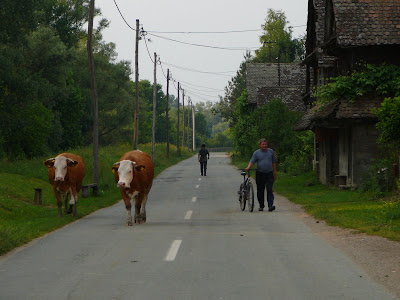Armed with a list of contacts for cheap places to stay around Croatia and a newly learned technique of riding along tram tracks to avoid the traffic, we left Zagreb, thankful to be heading for the countryside again.
It was a hot day, and by lunchtime we were so exhausted that we stopped in the shade of a large wine barrel, not realising there were picnic tables about 10 metres away. 85km later we rolled into Kutina, a nondescript town, where we camped in a half built guesthouse on a property with a few horses and other animals. The owner welcomed us kindly and refused any payment - something that would happen many times in Croatia.
Choosing to cycle across continental Croatia was perhaps a strange choice, considering the beauty of the coast (so we hear). There were very few facilities for tourists across the whole area east of Zagreb. Recovering from the "Homeland War" in 1991, much of the infrastructure is still being rebuilt and tourist promotion is still in the early stages. As a result, we received personalised treatment wherever we went, from man on a motorbike who stopped in the middle of a busy road to offer us some home picked cherries, to the popcorn seller who insisted we have some for free just because we were on bikes. On the downside, a lot of the time there were no "attractions" to see, or they would be difficult to access.

Rickety bridge on the way to Krapje
We did detour to Krapje, a village composed of traditional wooden houses, and a nearby wetland reserve. Stork nests on chimneys were a particular attraction.

Krapje in peak hour
The area between here and Novska had been mined during the "Homeland War" (1991) and not yet cleared.
(note to parents, it was all very safe)
Many buildings still bore evidence of heavy damage, especially as we neared Vukovar.
Arriving in Vukovar we met the Danube River. The town of Vukovar suffered particularly heavy casualties, being under seige for 3 months in 1991. Most of the buildings were completely destroyed and the reconstruction process is still in its early stages. As a result the scenery here is shocking and paints a macabre picture.





No comments:
Post a Comment